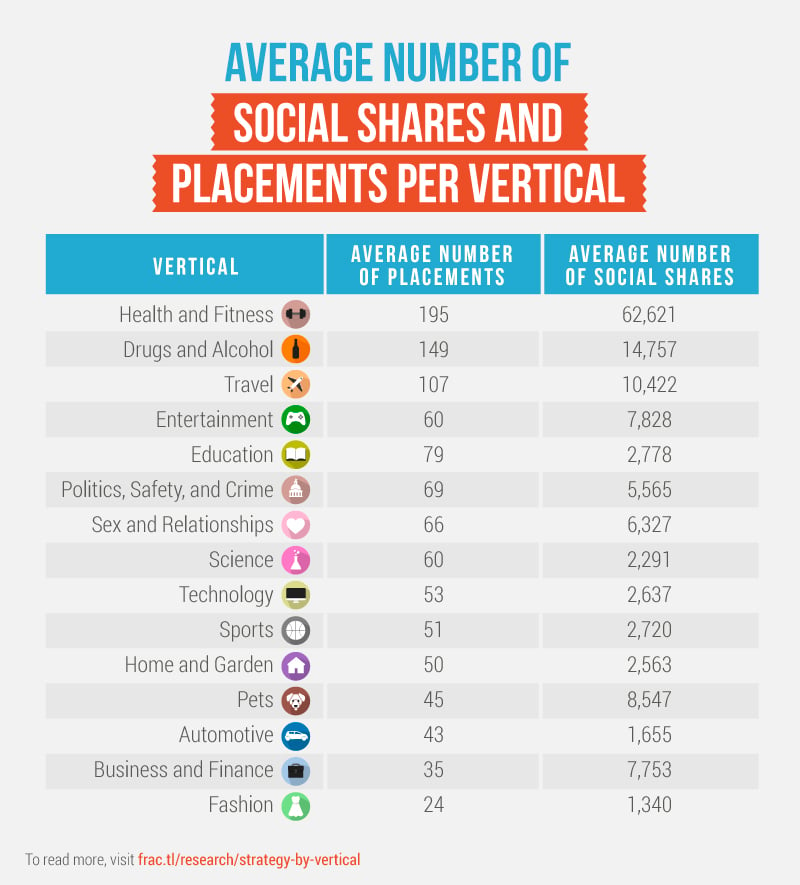Why Data Journalism Is the Secret to Engagement. Besides finding the average media placement and social share count rate for each vertical, we also were able to further pinpoint which verticals saw the most success with various data sources and strategies. Two Approaches for Content Engagement Across 15 Verticals Establishing your brand as an industry leader through authoritative content is becoming increasingly important as brands make that switch from advertisers to publishers. Insights on Data Sources for Different Verticals Data journalism is the core of each campaign we analyzed, all utilizing various research methods and sources to help create content geared towards the brand’s specific vertical and target audience. Sourcing the data can be broken down into two methods: data curation and original research. Data Curation To avoid bias and establish authority, curating hard data from reputable sources (i.e., open source government databases) or scraping social media networks for specific information allows content marketers to utilize existing data but add value by simplifying the information and pulling key findings. With higher-than-average media mentions and social shares, Drugs & Alcohol; Politics, Crime, & Safety; Automotive; and Education verticals successfully utilized data curation more than the other eleven verticals. By appealing to a very broad audience and curating data from a widely used platform, this campaign earned over 150 media mentions plus nearly 9,000 social shares. The latter allows for a lot of creativity; research methods range from surveys to surface swabs, leading to a plethora of new data for a campaign. Whether it’s through a tangential or niche vertical strategy, content should ultimately provide value to an audience through education or entertainment to break through the noise.

Data is everywhere, and nowadays, it is readily available and
easily accessible for marketers to utilize in their content
strategy. While many refer to a data-driven content strategy when
looking at ways to
better understand their audience and leverage influencers, a
data-driven approach can also mean creating content based in data
journalism.
As the
efficacy of outbound marketing and traditional advertising
continue to decline (even as their costs remain high), brands are
turning to inbound tactics like content marketing as they evolve
from advertisers to branded publishers. Data journalism is one of
the newer trends among content marketers, which utilizes
data analysis to extract compelling stories, often through
easy-to-digest visuals like infographics and videos.
Since ideation can be one of the most challenging and
intimidating aspects of content marketing, a data-driven,
journalistic approach offers a fresh source of inspiration. Helping
to satiate the internet’s nearly insatiable curiosity, this
research-based approach in content creation establishes authority
through thought leadership for brands. (highlight to
tweet)
Data journalism can fit into any content strategy in any
vertical. My team at Fractl utilizes this data-driven approach in
nearly every client content marketing campaign we produce. In order
to avoid comparing apples to oranges when it came to campaign
performance metrics across different industries, we set out to
delineate vertical benchmarks by sifting through nearly 350 of our
own client campaigns across various industries in a recent study.
Besides finding the
average media placement and social share count rate for each
vertical, we also were able to further pinpoint which verticals
saw the most success with various data sources and strategies.

Two Approaches for Content Engagement Across 15 Verticals
Establishing your brand as an industry leader through
authoritative content is becoming increasingly important as brands
make that switch from advertisers to publishers. Generating high
levels of engagement and a loyal following is important regardless
of your vertical, but we found two approaches to vertical content
strategy exist, depending on campaign goals.
Tangential Strategy and Traditional Virality
Tangential relevance to your brand (but still specific relevance
to the brand’s vertical) helps with content creation in terms of
diversity and frequency. For this approach, consider the
details defining the brand and its target audience, then
brainstorm topics and ideas that broadly or horizontally
relate back to the brand’s vertical. When searching for
the mass appeal that generates a lot of engagement from general
audiences, this tangential approach in content strategy is a great
option to consider—especially when working with a vertical that
doesn’t typically see viral-level engagement.
Ideally, creating broadly relevant content that appeals to a
socially-engaged audience’s motivations for sharing will help
generate those social shares and media mentions. Take, for example,
a UK brand in the online pharmacy and healthcare market. With the
goal of creating a viral hit, our creative team thought of a highly
relatable, highly emotional topic that tied back to the services
offered by the brand: body image and eating disorders. By
illustrating the “ideal” women in 18 countries around the world,
unique visuals grabbed the attention of a broad audience,
generating 3.5 million views from a single media placement—plus
900,000 social shares from over 600 other media stories.
Niche Strategy and Perceived Virality
As more and more content floods the internet, it becomes more
challenging to get noticed in a sea of mediocrity. Your brand is
forced to compete with not only direct competitors but quite
literally everyone. A more targeted approach through a
niche content strategy allows even the smallest brands to earn
exposure through
perceived virality, leading to stronger word-of-mouth
marketing, growing brand awareness, less competition, and most
importantly, more qualified leads.
Creating…
COMMENTS